|
Tricorne
The tricorne or tricorn is a style of hat that was popular during the 18th century, falling out of style by 1800, though actually not called a "tricorne" until the mid-19th century. During the 18th century, hats of this general style were referred to as "cocked hats". At the peak of its popularity, the tricorne varied greatly in style and size, and was worn not only by the aristocracy, but also as common civilian dress, and as part of military and naval uniforms. Typically made from animal fiber, the more expensive being of beaver-hair felt and the less expensive of wool felt, the hat's most distinguishing characteristic was that three sides of the brim were turned up (cocked) and either pinned, laced, or buttoned in place to form a triangle around the crown. The style served two purposes: first, it allowed stylish gentlemen to show off the most current fashions of their wigs, and thus their social status; and secondly, the cocked hat, with its folded brim, was much smaller than o ... [...More Info...] [...Related Items...] OR: [Wikipedia] [Google] [Baidu] |
Brim (hat)
A hat is a head covering which is worn for various reasons, including protection against weather conditions, ceremonial reasons such as university graduation, religious reasons, safety, or as a fashion accessory. Hats which incorporate mechanical features, such as visors, spikes, flaps, braces or beer holders shade into the broader category of headgear. In the past, hats were an indicator of social status. In the military, hats may denote nationality, branch of service, rank or regiment. Police typically wear distinctive hats such as peaked caps or brimmed hats, such as those worn by the Royal Canadian Mounted Police. Some hats have a protective function. As examples, the hard hat protects construction workers' heads from injury by falling objects, a British police Custodian helmet protects the officer's head, a sun hat shades the face and shoulders from the sun, a cowboy hat protects against sun and rain and an ushanka fur hat with fold-down earflaps keeps the head and e ... [...More Info...] [...Related Items...] OR: [Wikipedia] [Google] [Baidu] |
Bicorne
The bicorne or bicorn (two-cornered) is a historical form of hat widely adopted in the 1790s as an item of uniform by European and American army and naval officers. Most generals and staff officers of the Napoleonic period wore bicornes, which survived as widely-worn full-dress headdress until the 20th century. Historic use Descended from the tricorne, the black-coloured bicorne originally had a rather broad brim, with the front and the rear halves turned up and pinned together forming a semi-circular fan shape; there was usually a cockade in the national colours at the front. Later, the hat became more triangular in shape, with its two ends becoming more pointed, and it was worn with the cockade at the right side. That kind of bicorne eventually became known in English as the ''cocked hat'', but it is still known in French as the ''bicorne''. Worn in the side-to-side athwart style during the 1790s, the bicorne became normally seen fore-and-aft in most armies and navies fro ... [...More Info...] [...Related Items...] OR: [Wikipedia] [Google] [Baidu] |
Uniform
A uniform is a variety of clothing worn by members of an organization while participating in that organization's activity. Modern uniforms are most often worn by armed forces and paramilitary organizations such as police, emergency services, security guards, in some workplaces and schools and by inmates in prisons. In some countries, some other officials also wear uniforms in their duties; such is the case of the Public Health Service Commissioned Corps, Commissioned Corps of the United States Public Health Service or the France, French préfet, prefects. For some organizations, such as police, it may be illegal for non members to wear the uniform. Etymology From the Latin ''unus'', one, and ''forma'', form. Corporate and work uniforms Workers sometimes wear uniforms or corporate clothing of one nature or another. Workers dress code, required to wear a uniform may include retail workers, bank and post-office workers, public security, public-security and health-care workers, ... [...More Info...] [...Related Items...] OR: [Wikipedia] [Google] [Baidu] |
Chelsea Pensioner
A Chelsea Pensioner, or In-Pensioner, is a resident at the Royal Hospital Chelsea, a retirement home and nursing home for former members of the British Army located in Chelsea, London. The Royal Hospital Chelsea is home to 300 retired British soldiers, male and female (the latter since 2009), and is located on Royal Hospital Road. Historically, the term "Chelsea Pensioner" applied more widely, referring to both In-Pensioners and Out-Pensioners who live elsewhere. In- and Out-Pensioners The Royal Hospital was founded by King Charles II in 1682 as a retreat for veterans.Guidebook, p. 3 The provision of a hostel rather than the payment of pensions was inspired by Les Invalides in Paris. During the reign of King William III and Queen Mary II, the Royal Hospital was still under construction so they introduced a system for distribution of army pensions in 1689. The pension was to be made available to all former soldiers who had been injured in service, or who had served for more than ... [...More Info...] [...Related Items...] OR: [Wikipedia] [Google] [Baidu] |
Koninklijk Koetsier 2013 74
or (, Dutch language, Dutch for 'royal') is an Title of honor, honorary title given to certain companies and non-profit organisations in the Netherlands and to a lesser extent Belgium, by the monarchs of each country. It was first introduced by Louis Bonaparte in 1807, then Kingdom of Holland, King of Holland, who awarded the title to cultural associations. Companies awarded with the title may opt to use the English equivalent ''royal'' instead. It is comparable with the Royal Warrant of Appointment (United Kingdom), Royal Warrant in the United Kingdom. The word is also used in the names of some state-controlled organisations, such as the . In the Netherlands The monarch of the Netherlands has the right to appoint the royal title to a company or organisation. To qualify for a nomination, the company or organization has to meet the following conditions: * it has to be leading in its field of expertise; * it has to have national importance; * it has to be in existence for at l ... [...More Info...] [...Related Items...] OR: [Wikipedia] [Google] [Baidu] |
Women's Royal Naval Service
The Women's Royal Naval Service (WRNS; popularly and officially known as the Wrens) was the women's branch of the United Kingdom's Royal Navy. First formed in 1917 for the First World War, it was disbanded in 1919, then revived in 1939 at the beginning of the Second World War, remaining active until integrated into the Royal Navy in 1993. WRNS included cooks, clerks, wireless telegraphists, radar plotters, weapons analysts, range assessors, electricians and air mechanics. History First World War The Wrens were formed in 1917 during the First World War. On 10 October 1918, nineteen-year-old Josephine Carr from Cork became the first Wren to die on active service, when her ship, the RMS ''Leinster'' was torpedoed. By the end of the war the WRNS had 5,500 members, 500 of them officers. In addition, about 2,000 members of the WRAF had previously served with the WRNS supporting the Royal Naval Air Service and were transferred on the creation of the Royal Air Force. It was disb ... [...More Info...] [...Related Items...] OR: [Wikipedia] [Google] [Baidu] |
Shako
A shako (, , or ) is a tall, cylindrical military cap, usually with a visor, and sometimes tapered at the top. It is usually adorned with an ornamental plate or badge on the front, metallic or otherwise; and often has a feather, plume (see hackle) or pompom attached at the top. Origins The word ''shako'' originated from the Hungarian name for the ''peak'', which Hungarian border soldiers ( ''Grenz-Infanterie'') added around 1790 to their previously visorless stovepipe-style hats. Originally these hats were part of the clothing commonly worn by shepherds, before being added to the uniform of the Hungarian hussar in the early 18th century. Other spellings include ''chako'', ''czako'', ''sjako'', ''schako'', ''schakot'' and ''tschako''. From 1800 on, the shako became a common military headdress worn by the majority of regiments in the armies of Europe and the Americas. Replacing in most instances the light bicorne, the shako was initially considered an improvement. Made of heavy ... [...More Info...] [...Related Items...] OR: [Wikipedia] [Google] [Baidu] |
World War II
World War II or the Second World War, often abbreviated as WWII or WW2, was a world war that lasted from 1939 to 1945. It involved the vast majority of the world's countries—including all of the great powers—forming two opposing military alliances: the Allies and the Axis powers. World War II was a total war that directly involved more than 100 million personnel from more than 30 countries. The major participants in the war threw their entire economic, industrial, and scientific capabilities behind the war effort, blurring the distinction between civilian and military resources. Aircraft played a major role in the conflict, enabling the strategic bombing of population centres and deploying the only two nuclear weapons ever used in war. World War II was by far the deadliest conflict in human history; it resulted in 70 to 85 million fatalities, mostly among civilians. Tens of millions died due to genocides (including the Holocaust), starvation, ma ... [...More Info...] [...Related Items...] OR: [Wikipedia] [Google] [Baidu] |
World War I
World War I (28 July 1914 11 November 1918), often abbreviated as WWI, was one of the deadliest global conflicts in history. Belligerents included much of Europe, the Russian Empire, the United States, and the Ottoman Empire, with fighting occurring throughout Europe, the Middle East, Africa, the Pacific, and parts of Asia. An estimated 9 million soldiers were killed in combat, plus another 23 million wounded, while 5 million civilians died as a result of military action, hunger, and disease. Millions more died in genocides within the Ottoman Empire and in the 1918 influenza pandemic, which was exacerbated by the movement of combatants during the war. Prior to 1914, the European great powers were divided between the Triple Entente (comprising France, Russia, and Britain) and the Triple Alliance (containing Germany, Austria-Hungary, and Italy). Tensions in the Balkans came to a head on 28 June 1914, following the assassination of Archduke Franz Ferdin ... [...More Info...] [...Related Items...] OR: [Wikipedia] [Google] [Baidu] |
List Of Nicknames Of Presidents Of The United States
Presidents of the United States have often acquired nicknames, both flattering and unflattering. This list is intended to note those nicknames that were in common use at the time they were in office or shortly thereafter. George Washington * The American Cincinnatus: Like the famous Roman, he won a war, then became a private citizen instead of seeking power or riches as a reward. He became the first president general of the Society of the Cincinnati, formed by Revolutionary War officers who also "declined offers of power and position to return to his home and plough". * The American Fabius for his Fabian military strategy during the Revolutionary War * The Father of His Country John Adams * The Colossus of Independence for his leadership in Congress in 1776 * Old Sink or Swim, for the speech in which he vowed "sink or swim, live or die, survive or perish, I am with my country from this day on." * His Rotundity for his girthy bodily figure Thomas Jefferson * The Apostle of D ... [...More Info...] [...Related Items...] OR: [Wikipedia] [Google] [Baidu] |


.jpg)





